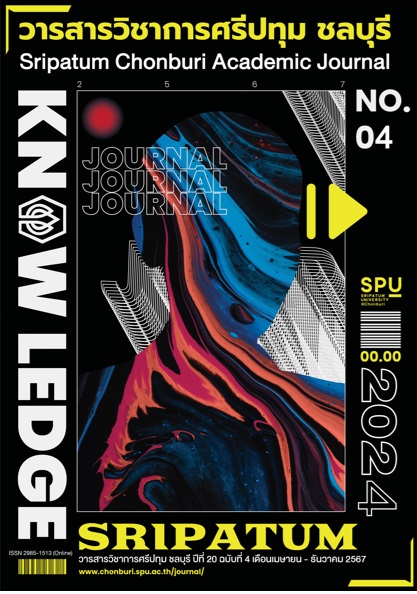ELECTRONIC WORD-OF-MOUTH, DESTINATION IMAGE, AND MOTIVATION AFFECTING DECISION TO TRAVEL TO TIBET AUTONOMOUS REGION AMONG TOURISTS IN THE NORTHERN REGION, THAILAND
Keywords:
Electronic Word-of-Mouth, Destination Image, MotivationAbstract
The purposes of this study were to study 1) the opinion level of the Electronic Word-of-Mouth, destination image, motivation, and the decision to travel to Tibet autonomous region among tourists in the Northern region of Thailand and 2) factors affecting their decision to travel there. The samples selected by the specific random sampling method were 385 consumers aged 20 years and up who decided to travel to Tibet autonomous region. The study tool was an online questionnaire. Data were analyzed by frequency, percentage, mean, standard deviation and multiple regression analysis (enter regression method).
The results showed that the Electronic Word-of-Mouth, destination image, motivation, and decision to travel to Tibet autonomous region among tourists in the Northern region of Thailand were at a high level. The Electronic Word-of-Mouth (β=.32), destination image (β=.28), and motivation (β=.22) affected the decision to travel there with statistical significance at the .05 level. This could predict the decision to travel to Tibet autonomous region among tourists in the Northern region, Thailand at 53.90 percent.
References
จาง หลิง. (2559). รูปแบบการดำเนินชีวิต ความไว้วางใจ บุคลิกภาพ ภาพลักษณ์ และความดึงดูดใจ ของสถานที่ท่องเที่ยวที่มีผลต่อการตัดสินใจเดินทาง มาท่องเที่ยวที่กรุงเทพมหานครของนักท่องเที่ยวชาวจีน. การค้นคว้าอิสระปริญญาบริหารธุรกิจมหาบัณฑิต คณะบริหารธุรกิจ มหาวิทยาลัยกรุงเทพ.
เดลินิวส์ออนไลน์. (2566). ทิเบตผลักดันการพัฒนาคุณภาพสูง ส่งเสริมการท่องเที่ยว (ออนไลน์). เข้าถึงได้จาก: https://www.dailynews.co.th/news/2008467 [2566, 6 เมษายน].
บุญใจ ศรีสถิตย์นรากูล. (2555). การพัฒนาและตรวจสอบคุณภาพเครื่องมือวิจัย: คุณสมบัติการวัดเชิงจิตวิทยา. กรุงเทพฯ: โรงพิมพ์จุฬาลงกรณ์มหาวิทยาลัย.
พรชนก เหลืองอ่อน. (2559). การรับรู้ภาพลักษณ์การท่องเที่ยวที่ส่งผลต่อความตั้งใจเดินทางไปท่องเที่ยวไต้หวันของนักท่องเที่ยวชาวไทยในเขตกรุงเทพมหานคร. การค้นคว้าอิสระปริญญาบริหารธุรกิจมหาบัณฑิต คณะบริหารธุรกิจ มหาวิทยาลัยกรุงเทพ.
มณีหยก พานิช. (2564). ภาพลักษณ์ของแหล่งท่องเที่ยวและแรงจูงใจในการเดินทางท่องเที่ยวของนักท่องเที่ยวชาวไทยที่ส่งผลต่อการตัดสินใจในการมาเยือน เกาะหลีเป๊ะ จังหวัดสตูล. การค้นคว้าอิสระปริญญาศิลปศาสตรมหาบัณฑิต สาขาวิชาการจัดการการท่องเที่ยว, คณะการท่องเที่ยวและการโรงแรม มหาวิทยาลัยธุรกิจบัณฑิตย์.
สำนักงานปลัดกระทรวงการท่องเที่ยวและกีฬา. (2565). รายงานภาวะเศรษฐกิจการท่องเที่ยว ปีที่ 3 ฉบับที่ 2/2565 (ออนไลน์). เข้าถึงได้จาก:
https://www.mots.go.th/news/category/700 [2566, 14 เมษายน].
หลี เฉิงฉวย และบุณฑวรรณ วิงวอน. (2561). ตัวกำหนดการตัดสินใจของนักท่องเที่ยวชาวจีนในการเลือกแหล่งท่องเที่ยวในจังหวัดเชียงใหม่. สักทอง : วารสารมนุษยศาสตร์และสังคมศาสตร์ (สทมส.), 24 (ฉบับพิเศษ), หน้า 153-163.
อัครวัฒน์ ทรัพย์มณีสมชัย และธนกร สิริสุคันธา. (2562). การสื่อสารแบบปากต่อปากทางอิเล็กทรอนิกส์และส่วนประสมทางการตลาด ที่มีต่อการตัดสินใจท่องเที่ยวในประเทศไทยของกลุ่มเจเนอเรชั่นวาย. วารสารบัณฑิตศึกษาปริทรรศน์ มจร วิทยาเขตแพร่, 5(1), หน้า 51-66.
อรุณรุ่ง อนุรักษ์สกุล. (2558). บทบาทของเขตปกครองตนเองทิเบตต่ออุตสาหกรรมการท่องเที่ยวจีน (ออนไลน์). เข้าถึงได้จาก: http://isas.arts.su.ac.th/?p=2351 [2566, 9 เมษายน].
Baloglu, S., & McCleary, Ken W. (1999). A model of destination image formation. Annuals of tourism Research, 26(4), pp. 868-897.
Beard, J.G., & Ragheb, M.G. (1983). Measuring Leisure Motivation. Journal of Leisure Research, 15(3), pp. 219-228.
Cochran, W.G. (1977). Sampling Techniques (3rd ed.). New York: John Wiley & Sons.
Crompton L. (1979). Motivations for pleasure vacation. Annals of Tourism Research, 6(1), pp. 408-424.
Gaiserc, T. J., & Schreiner, A., E. (2009). Research Standards and Ethical Consideration. In A Guide to Conducting Online Research. (pp. 25-35). SAGE Publications Asia-Pacific Pte Ltd, Singapore.
Jalilvand, M. R., Samiei, N., Dini, B., & Manzari, P. Y. (2012). Examining the structural relationships of electronic word of mouth, destination image, tourist attitude toward destination and travel intention: An integrated approach. Journal of destination marketing & management, 1(1-2), pp. 134-143.
Likert, R. (1970). The Human Resources: Cases and Concept. New York: Hart Cout Brace B. World in Cooperated.
Rovinelli, R., & Hambleton, R. (1976). On the use of content specialists in the assessment of criterion-referenced test item validity. In Paper presented at the annual meeting of AERA, San Francisco. Eric Document # ED121845. (pp. 19-23), San Francisco: CA, Educational Research Association.
Downloads
Published
Issue
Section
License
Copyright (c) 2024 Sripatum Chonburi Academic Journal

This work is licensed under a Creative Commons Attribution-NonCommercial-NoDerivatives 4.0 International License.
บทความทุกบทความเป็นลิขสิทธิ์ของวารสารวิชาการศรีปทุม ชลบุรี



